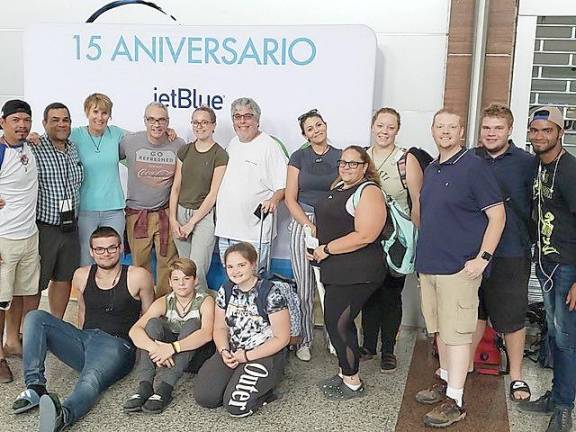Teens and adults build a home in the Dominican Republic
Goshen. Volunteers found the mission trip tough, inspiring, and eye-opening. They met villagers whose hope for the future and love of learning thrived amid dire poverty. And they witnessed climate change "happening in real time."

A sizable group of 15 teens and adults spent the week of July 20-27 in the Dominican Republic building a home for a local family.
“On the last day that we were there, after we built the house, and when I saw how happy the family was in having a home, it made coming here so rewarding for me,” said Trent Cline-Larsen, a 17-year-old from Scotchtown.
The First Presbyterian Church of Goshen sponsored the mission trip. It wasn't easy. It took strength of character and physical endurance just to get to the destination, before any building took place.
Flying out of Newark Airport, the group landed in the beautiful old city of Santo Domingo, the capital of the Dominican Republic. After a night’s rest, they traveled an arduous five hours by bus to Derrumbadero, a small town about 10 miles from the Haitian border.
Accommodations there consisted of a single room loaded with bunk beds and mosquito netting. The group’s diet was mostly rice and beans, spaghetti and yucca, with very little protein like chicken or fish. The volunteers had a chance to sleep.
It was a 10-minute car ride from Derrumbadero to Caimonial, where the volunteers spent their days building.
“I shoveled gravel, passed cement buckets, and climbed ladders to paint,” said Carol Phelan, an optometrist from Warwick who joined the group with her son, Charles. “I did what I could do to help. And I don’t like heights!”
She was impressed with the child care.
“The children were precious," she said. "No hover parents there — the whole village watched the children."
Her biggest surprise happened when she came upon a tarantulas’ nest.
“The spiders were bigger than my hand!” she exclaimed.
'We're privileged with basic things'
The homes are made of a combination of wood and cement, reinforced with barbed wire instead of rebar. Every home is poured concrete. Palm trees are used as siding, and later painted. Each four-room house has a tin roof but no electricity and no plumbing.
“In the village, the barrels of water aren’t clear," Phelan said. For us it was only a week — for them it’s all the time. We’re privileged with basic things like water. We turn on the tap and we have water."
Mark Glasse, the trip coordinator, said, “We saw climate change happening in real time on the ground as we were there. Soil nutrients are washed away."
Haitians come over the border and abscond with trees, to turn into charcoal, a cooking source, he said.
"Drought has left the ground parched and cracked," said Glasse. "Moisture, if available, wouldn’t even penetrate the ground. The time to act and save the world is now. In a few short years, these people won’t be able to feed themselves. Climate change, global warming, whatever you want to call it, is happening. Fields of corn there are withered, with drying leaves,."
Glasse said it is a poverty-ridden area.
“There’s some farming, but most people have no means of employment," he said. "There’s a level of hopelessness. Small stores dot the neighborhoods selling snacks, Gatorade, food like that, with about one-third of the space selling liquor. On the up side, there is a decent school in the area and trip organizer, Bridges to Community, built a community center with classrooms, meeting rooms, and a library. It’s well-utilized.”
Charles Phelan, 17, sees a bit of hope.
“We observed such poor living conditions, but the people still have hope, so much hope," he said. "It was a pretty inspiring trip.”
His mother, who was on this trip with him, and his three sisters have gone on mission trips in the past, so he knows what mission work demands.
Fifteen-year-old Emma Boardman of Chester also found inspiration on the trip.
"I was unsure about going on the trip, but once I got there and started to work, I realized I made the right choice, because it opened my eyes to what I have versus what others have," she said. "I found it inspiring.”
Glasse said, "This is a trip that everyone should take. Teens especially learn to appreciate what they have. They experience a level of poverty not like anywhere here in the U.S. It’s an eye-opener. We all can learn from being a part of a trip like this.”
The trip back to Santo Domingo was another eye-opener: the volunteers passed multiple armed military personnel looking for Haitian immigrants sneaking into the country.
"I was unsure about going on the trip, but once I got there and started to work, I realized I made the right choice, because it opened my eyes to what I have versus what others have. I found it inspiring.” --Emma Boardman, 15, of Chester